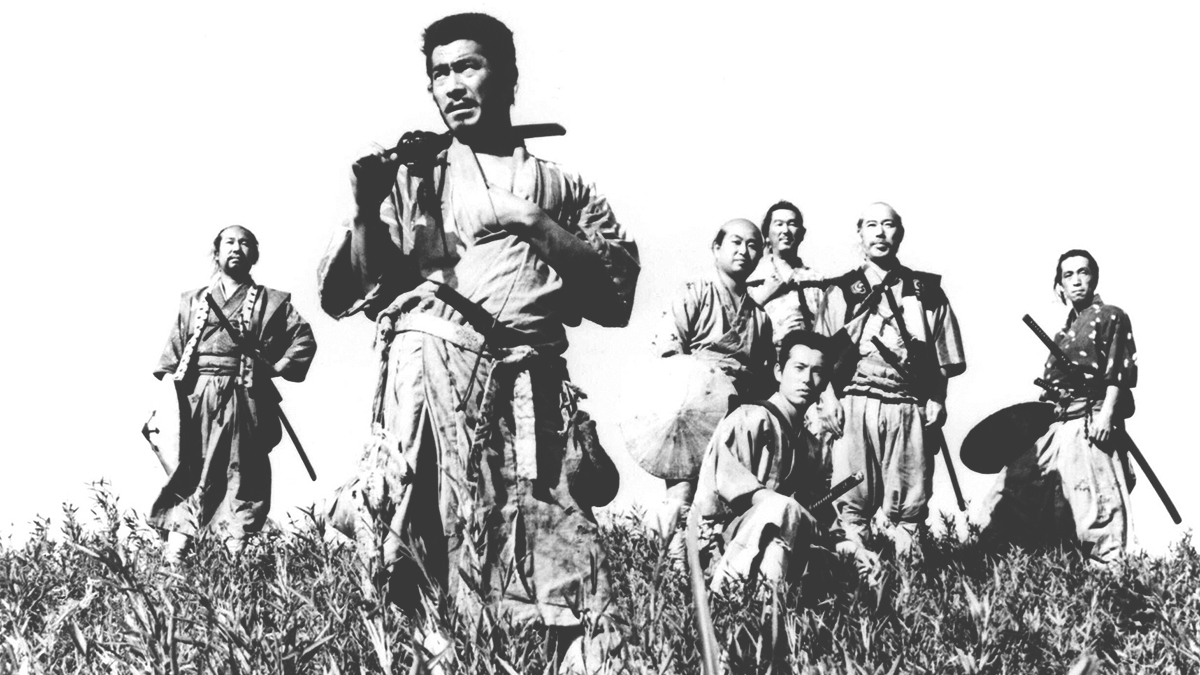Seven Samurai (1954)
Film and Plot Synopsis
Seven Samurai takes place in Japan in the 16th Century. An army of bandits continually raids a poor village for their crops of rice. The town’s patriarch advises these villagers to hire a Ronin to help defend their village from the invaders. When four of the farmers head to town to hire one, they have trouble finding a defender whom they can afford; they can only offer three meals of rice per day and lodging for their troubles. Things look bleak for the men as no one takes them up on their offer until they come across Kambei Shimada. He tells them that they need six other samurai to help protect their land. He himself sets out to recruit five samurai and one brave loner named Kikuchiyo. Everyone then moves to the village where Kambei strategizes a defense. The other samurai train the farmers basic self defense, and help fortify the village itself against the marauding bandits. Soon a climatic battle will determine the fate of all involved.
‘Seven Samurai’ Movie Summary
 Seven Samurai begins as a gang of marauding bandits rides up to a small mountain farming village. However, before the bandits ride into the town, their chief recognizes they have ransacked this village before. He decides to pass on their attack and come back after the village has completed its harvest in a couple of months. Unbeknownst to the bandits, a villager overhears this and reports this to village elder. The elder decides that they should hire some samurai to defend the village and kill the bandits. Since they have nothing to offer but food, the elder tells them to “find hungry samurai.”
Seven Samurai begins as a gang of marauding bandits rides up to a small mountain farming village. However, before the bandits ride into the town, their chief recognizes they have ransacked this village before. He decides to pass on their attack and come back after the village has completed its harvest in a couple of months. Unbeknownst to the bandits, a villager overhears this and reports this to village elder. The elder decides that they should hire some samurai to defend the village and kill the bandits. Since they have nothing to offer but food, the elder tells them to “find hungry samurai.”
A group of men go to the city, but find that no samurai want to work for mere food. Then they encounter an wizard like samurai with a stylish haircut who appears to have lived out on the Dune Sea by the name of Kambei. Kambei impresses them when he rescues a young boy taken hostage by a thief. Another young samurai, Katsushirō, also sees the rescue and asks the elder samurai if he may become his disciple. Kambei insists that he walk with him as a friend and agrees to help the farmers.
Kambei recruits more rōnin
With Katsushirō’s assistance, Kambei recruits four more rōnin: Gorobei Katayama, who is the clever and good natured samurai; Heihachi, a good-humored samurai with mediocre swordsmanship; Shichirōji, an old friend of Kambei’s; and Kyūzō, a quiet master swordsman that you can image being played by James Coburn in a western a few years later. The six samurai begin the journey to the mountain town and are followed by Kikuchiyo, a jokester samurai who is the built in comedy relief of the film. Kikuchiyo had previously been rejected for the mission by Kambei, but now the wise old samurai sees the young samurai as useful.
When the Samurai arrive, the villagers cower in their homes fearful of their hired saviors. The Samurai feel insulted by their cold, unwelcoming reception. Suddenly, the village alarm is raised and the villagers, fearing that the bandits have returned, charge out of their homes and beg the Samurai to protect them. Kikuchiyo, who raised the false alarm, rebukes the villagers for their poor behavior. The Samurai accept him, bringing their number to seven.
As the long film progresses, the Samurai and the villagers slowly come to trust each other. However, when the Samurai discover that the villagers have murdered and robbed fleeing samurai in the past, they become angry. Kikuchiyo chasitizes his comrades for ignoring the hardships that the villagers have to overcome to survive, including harassment from the warrior class and bandits. This reveals his origins as a farmer’s son to Kambei. The anger the younger samurai felt turns to shame.
The village prepares for battle
The Samurai and the villagers construct fortifications and train the farmers for battle. Katsushirō, the youngest samurai, begins a relationship with Shino, the daughter of a villager who has been forced to masquerade as a boy by her father to protect her from the supposedly lustful samurai. Katsushirō and Shino keep their relationship secret from both Shino’s father and the other samurai. However, the ever watchful Kyūzō discovers their secret, but keeps it Katsushirō’s secret.
Eventually, the bandits return in the form of three scouts. Two of the scouts are quickly dispatched, but one of the scouts is captured, and reveals the location of the bandit camp. Three of the samurai, guided by a villager named Rikichi, go to the camp to conduct a preemptive strike. The samurai set fire to one of the bandits’ strongholds. As the bandits run out of the burning building, the samurai cut them down.
When a woman emerges from the bandits’ burning house, she sees Rikichi and runs back inside to perish in the flames. Rikichi reveals that this was his wife, who had been kidnapped and raped by the bandits. One of the samurai, Heihachi, is killed in the attack.
The bandits attack
Soon, the bandits attack the village, but are confused by the improvements and barriers created for the village. The bandits suffer heavy loses while trying to navigate the new obstacles. However, the bandits have a huge advantage in the form of three muskets. The silent Kyūzō undertakes a solo mission and returns with a musket. However, the inexperienced Kikuchiyo abandons his post to get another musket.
In the process, he leaves his contingent of villagers leaderless. Although he succeeds, the bandits attack his post, overwhelming and killing some of the villagers. Kambei is forced to send reinforcements, leaving the main post undermanned when the bandit chief leads a charge against this position. Although they are repelled, Gorobei and Yohei are lost in the battle.
Kambei, who is now down several villagers and three samurai, develops a new strategy to allow one bandit to enter through a gap in the fortifications, block the rest with a “wall” of spears, and kill the lone bandit. This succeeds several times.
On the second night of the bandits’ seige, Kambei instructs everyone to prepare for a final, decisive battle. However, in the midst of planning Shino’s father discovers his daughter secret relationship with Katsushirō and beats Shino. Katsushirō hangs his head in shame while the rest of the Samurai and villagers look on. As it begins to rain, everyone goes back to their posts. When morning breaks, Kambei orders his forces to allow the remaining bandits in.
The end is near
Most of the attackers are killed, but their leader takes refuge in a hut where the women and children are hiding. In what is portrayed as a dishonorable act, he shoots Kyūzō from the hut, killing him. A despondent Katsushirō seeks to avenge his hero, but an enraged Kikuchiyo charges ahead of him, only to be shot himself. Kikuchiyo kills the bandit chief before dying. Kambei and Shichirōji sadly observe “we’ve survived once again”.
Afterward, the three surviving samurai watch the villagers happily planting the next crop. They reflect on the relationship between the warrior and farming classes: though they have won the battle, they have lost their friends with little to show for it. “Again we are defeated,” Kambei muses. “The winners are those farmers. Not us.”
Additional Film Information
- Listen to our film review
- Seven Samurai Criterion webpage
- Peruse IMDb’s article on Seven Samurai
- Learn more Seven Samurai information at Wikipedia
- Get Seven Samurai numbers at Box Office Mojo
- Find out what people think about Seven Samurai at Metacritic
- Read Seven Samurai reviews from the folks at Rotten Tomatoes
Rate the Film!
Our Rating
Our Rating
Toho released Seven Samurai on April 26, 1954. Akira Kurosawa directed the film starring Toshirô Mifune, Takashi Shimura, and Keiko Tsushima.
